Wave energy: closer and closer
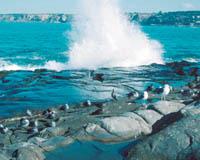
In the 1970s, after the famous "oil crisis", the most advanced countries began to seriously develop their research in the field of wave energy. The objective is that the electric energy of the waves is twisted and economically profitable to be able to exploit it commercially. Engineers work in different parts of the world. And surprisingly, in this field the Americans are not in the lead, the Europeans and the Japanese are the most advanced. At the European level, the British and Norwegians have worked the most.
Wave converters
To date, a dozen systems of transformation of the kinetic energy and potential of the waves into electric energy have been invented: wave converters, fixed and floating, anchored on the seabed and settled on the coast. In open sea the energy of the waves is between 3 and 8 times greater than in coast. In this sense, the use of waves in open sea may be the most appropriate, but the cost of bringing electricity from sea to land is very high, so most of the invented systems are to be located on the coast itself or by the coast.
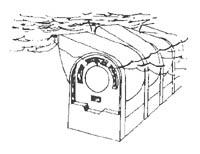
The transformation of wave energy into useful energy becomes first a mechanical movement or the pressure of a fluid to later convert it into electric energy. But this is not easy, as while the wave cycle – period – is several seconds, the electric generator must turn much faster.
One of the first invented systems is the "Duck Salter", invented in the 1970s by Professor Stephen Salter of the University of Edinburgh. It consists of a series of floats of special shape, about 25, which can circulate on an axis tufted on the seabed. In the face of aggressive waves, the wave pushes the float from the bottom up and, after passing the wave, the float descends to the initial position. The floats transmit this movement to the shaft and, by means of the gear, it is used to move the electric generator. Instead of the mechanical system, the balance movement of the floats can be used to compress a fluid, then turn the turbine by injecting the fluid into a turbine and make it turn the electric generator. It is an interesting system, although it requires technological development.
However, the most developed system so far is that of oscillating water columns (OWC). The system is based on the fact that if a vertical conduit is placed with the bottom submerged in the water and fixed so that the pipe remains still, with the passage of the waves the water inside the tube, the water column, circulates up and down. If the top of the mainland tube is closed, the air inside will be compressed when the water rises and decompressed or expanded when the water descends. The air, therefore, is captivated in the tube. If circulated through this air chamber, the air will come out and penetrate strongly when the water rises and falls. By placing the turbine in that circle, the air moves the electric generator. This allows obtaining electrical energy.
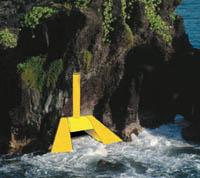
The problem was that most turbines only worked when air circulated in a sense. But this problem is currently overcome thanks to the two-way turbine. In this type of turbine (for example in the Wells turbine) the rotor always moves in the same direction, regardless of the sense of the fluid that crosses it. This is achieved thanks to the special design of the blades (see in the drawing the section of the blades). Therefore, the use of this type of turbines facilitates the obtaining of electric energy, since conventional electric generators –alternators– revolve in a single sense.
This type of wave converters can be installed in coastal areas such as sea cliffs. The advantage over offshore systems is that the electric generator, turbine and electrical equipment are on the ground, so repair and maintenance operations are much cheaper. On the other hand, the environmental impact must be taken into account, among others, the landscape impact.
OWC systems are well developed and have been tested in places like the UK, Norway and Japan. Higher performance OWCs are currently being developed. This is the converter that will soon be located in Azores, promoted by the European Union: Designed to achieve an electric power of 400 kilowatts, it will be the first European pilot plant of industrial size.
The future?
To date, numerous attempts have been made to govern and use wave energy, but an economically profitable system has not yet been achieved. However, in the last 25 years there have been significant technological advances that reach the gates of economic profitability. In addition, the cost of environmental impact in calculating the economic profitability of energy systems is currently not taken into account. If this were internalized in the cost of energy, renewable energy sources would be much more profitable than they are now. Therefore, these energy sources that can now hardly compete in the market, as is the case of wave energy, will be accepted and appreciated thanks to the advance of technology tomorrow or past, or the increase in prices of non-renewable energies.
Giant whale
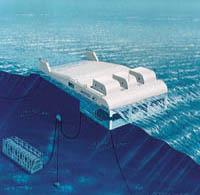
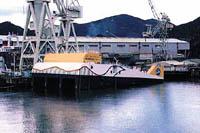
The Japanese have been researching wave energy transformation systems for some time. In the 1970s, the Kaimei prototype was embarked, a boat with oscillating water columns. After several tests, since 1987 the development of a new floating artifact, called Giant Balea, has begun. The new prototype is 50 m long, 30 m wide and 12 m high. It floats in the water, submerging two thirds of its height under water. The prototype consists of three air chambers (with a turbine) to transform wave energy into pneumatic energy. It is, therefore, a set of oscillating water columns on the water, that is, it is not seated on the coast but anchored on the seabed, with the "mouth" on the direction of the waves. The wave enters through the mouth of the whale, pushes the air from the chambers up, and then leaves the "belly" of the whale. Compressed air moves the turbine. At the exit of the surf there is a depression in the air chamber and the air enters by force, moving again the turbine. It is estimated that the Giant Whale will have a total power of 110 kW. The whale has several floating chambers, three behind the air chambers, one on the sides and three on the tail. Last year he set sail in the Japanese Gokasho Bay in the Pacific, and for two years he will be on trial. In total they will measure 48 variables. The open sea trials aim to compare the results obtained with those obtained at the theoretical and small-scale level in the test rafts; to know the characteristics of energy absorption, to test the anchor system and to know the hydrodynamic loads and other loads affecting the structure. At the same time, the behavior of systems in the real sea and not in artificial ponds, such as turbines or generators, and the influence of the system on the coastal environment will be analyzed.
Buletina
Bidali zure helbide elektronikoa eta jaso asteroko buletina zure sarrera-ontzian











